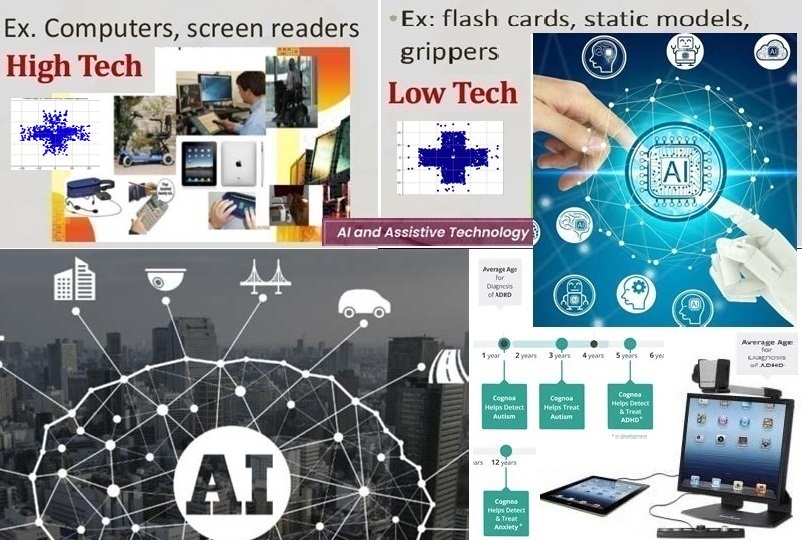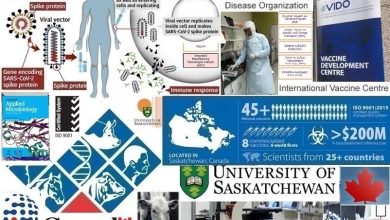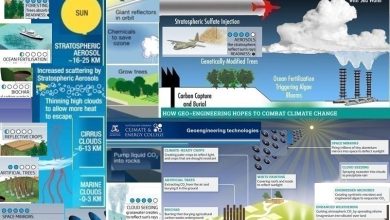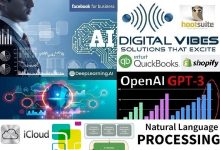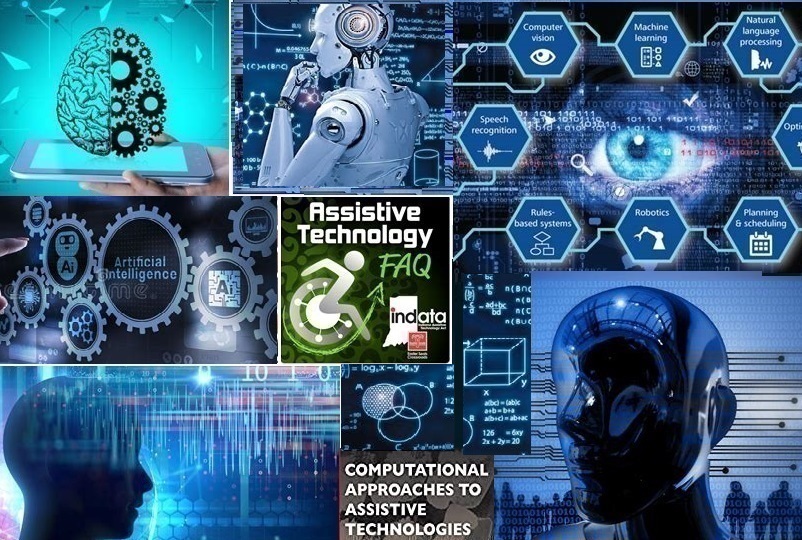
AI has revolutionised industries and transformed the tasks that computers perform. With the fast development of computer science and information technology, AI has improved from theory to application, resulting in all industries suffering a loss of countless jobs. Smart companies are aware that AI has impacted their businesses and are not only embracing AI technology to analyse upcoming trends, forecast growth, predict outcomes, and streamline their daily processes, but also discovering innovative ways to create the first ever AI-based jobs. The next level of AI is augmented intelligence (cognitive technology) which focuses on the role of augmented intelligence namely to enhance human intelligence. As an assistive technology, AI offers opportunities for people with hearing, perception, vision, mobility, and learning disabilities.
Think of AI as a form of intelligence that answer questions, find solutions, solve problems, and make predictions. AI describes the technology which performs activities that usually require human intelligence as well as the multi-disciplinary field of science to develop and understand the technology; the science of creating intelligent computer programs, software, and systems for tasks that involve human intelligence and behaviour. AI is an area of cross-disciplinary research that spans computation, mathematics, neuroscience, robotics, and sensory systems to resolve problems via programming technology combined with big data and machine learning (deep learning). AI databases use both structured and unstructured data to implement complex algorithms, understand information, perform tasks, adapt to changing inputs and environments, and develop optimisation methods in computer production.
AI permits machines and computer applications to mimic human intelligence and learn from experience via discussion and algorithmic training. Being the fastest-growing technology to train robotics with real-world data, the purpose is to power tasks performed by humans. The more data a robot uses, the better its performance. Machine learning (ML) and neural networks have an extensive range of uses in agriculture, cybersecurity, education, entertainment, health care, national defense, transportation and manufacturing. Machine learning as a branch of AI, is a method of data analysis based on the knowledge that systems can obtain from facts, organise patterns, and form decisions with minimal human intervention. In recent years, advances in speech processing, computer vision, natural language processing, emotional computing, and ML have been gradually applied to automatic analysis and modelling of behavioural data. The difference between the technologies AI and ML on the one hand and assistive AI technology on the other hand is that AI and ML can independently make decisions while AT on the other hand has an assistive function which leaves the decision-making to humans. AI and biometrics such as voice recognition can estimate a person’s biometric voice signature by analysing the individual’s voice pattern (accent, pitch speed, and tone). Such AI-powered voice recognition can be used for validation in workplaces. AI can monitor emerging complications, regulate the need for pre-emptive maintenance, and direct human behaviour for optimum safety and security.
Canada is a world-leading artificial intelligence research centre. Working in AI in Canada means cooperating with academics, the government, and the private sector. Robotics in Canada includes the foundation, innovation, assembly, and production of machines. Robotics intersects with various other electronic and engineering disciplines such as AI, bioengineering, computer science, nanotechnology, and mechatronics (the engineering of electrical and mechanical systems). Robotics is a separate component in Artificial Intelligence to support the study of the creation of intelligent machines or robots. Robotics combines electrical- and mechanical engineering and computer science and engineering (as they have electrical components), mechanical construction, and are programmed with programming language. Intelligent Robotics uses AI to boost collaboration between people and devices. AI helps robots to adapt to dynamic situations and communicate naturally with people. Automation and robotics programs at Ontario colleges prepare students for work in several fields, from computer control methods to robotics, hydraulics, and pneumatics. Emphasis on assembly languages means students are prepared to work in the computer and IT field as well as in the engineering industry. The University of Toronto brings together established and emerging leaders in robotics who make significant contributions to the University of Toronto Robotics Institute through service, mentorship, community development, and thought leadership. The University of Toronto Robotics Institute is the largest and most distinguished robotics institute in Canada. Dr Andrew Goldenberg is the founder of Robotics at the University of Toronto where he has been since 1982 as Professor of Mechanical and Industrial Engineering, cross appointed in the Institute of Biomaterials and Biomedical Engineering and the Electrical and Computer Engineering Department. The University of Toronto, Canada, boasts the Intelligent Assistive Technology and Systems Lab (IATSL) in the Department of Occupational Science and Occupational Therapy. Dr Wang is an Affiliate Scientist at Toronto Rehabilitation Institute and a member of AI and Robotics in the Rehabilitation team. UT researchers regularly host robotic activities to involve the community. These events include laboratory tours, demonstrations, and workshops.
Assistive technology (AT) can be divided into groups which range from simple technologies to speech-generating devices (SGD) that provide a physical voice to those who don’t have one. These groups are low-tech devices (anything that does not need electricity), mid-tech devices (inexpensive and easy to operate), and high-tech devices (special-purpose computers and AI). Examples of high-tech AT devices are augmentative and alternative communication devices, hearing aid and/or assistive listening devices, text to speech, and picture to speech. The MyEye 2 is designed as a small, wearable camera that attaches to any pair of spectacles, focuses on camera technology (combined with Google Lens’ identification algorithm), identifies objects in front of it, and reads any text within its frame. The second part of this group can be products or services (devices [that function as people’s eyes, ears, and voices], equipment, items, software programs, systems, tools, or support) that ranges from simple household items to complex innovations such as joysticks, screen readers, speech recognition systems, touch screens, word prediction software, eyeglasses, hearing aids, pressure care mattresses, and wheelchairs that is used to increase the functional ability of disabled people and maintain the independence of individuals who will not be able to participate within their homes, careers, and school settings without it. Without these devices many people would be unable to communicate with others, unable to follow careers, or to lead independent lives.
Assistive Technologies (AT) spur innovation. The 15th International Convention on Rehabilitation Engineering and Assistive Technology (i-CREATe 2022) in Hong Kong provided an international conference platform where global Student Innovation Challenges and exhibitions presented innovative applications, equipment, techniques, and technologies. Since most assistive technologies either imitate keyboard functionality or touchpad exchanges, or communicate through the keyboard or mouse, the main challenge for developers is to design connections that do not depend upon a specific input function or technology. Additional AI improved personalisation methods can be added to increase usability such as text interpretation and text to symbol translations. Deep learning (DL), which is the root of image recognition technology, has made notable improvement in recent years. DL can be used on personal computers; therefore, it is possible to compare multi-dimensional information. It is also viable to accurately compare spectrographs with audio soundtracks and pictures.
AT has made excessive improvements in its incorporation with Artificial Intelligence of Things (AIoT) devices. AIoT processes and studies the huge volume of statistics produced by Internet of Things (IoT) devices and applies Artificial Intelligence models, particularly machine learning, to determine patterns to generate insight. Manual devices allow the user to self-feed with the assistance of a non-electrical aid which include modified cutlery, grasping aids, height-adjustable tables, manual mobile arm supports and spring/hydraulic feeders. Some assistive feeding technologies include electrical advancements, manual aids, and robotic technologies. Several people in wheelchairs cannot control a powered wheelchair with the standard joystick interface; therefore, a robotic wheelchair can provide a user with comfort driving assistance and competent travelling. Many types of technology fund caregiving: clothing with polypropylene fibres that stimulate muscles, feeding and bathing machines, assistive devices such as medicine dispensers, intelligent ambulatory walkers for those with both vision and mobility impairment, medication reminders, and safety alarms. AT focuses on giving patients a voice – brain-computer interfaces, IoT and AI to fuel the development of assistive technology devices. There are telecare devices that range from regular telephones to picture phones. In addition to motorised devices, AT is intensely involved in AI, neuroscience, and machine learning. Wisconsin’s Assistive Technology Program (WisTech) – assistive technology includes the services required to obtain and use the devices, including education, evaluation, customisation, and restoration. WisTech is funded to offer assistive technology training, device demonstration, device loans, financing programs, and device re-distribution and exchange. The mission of the new Wisconsin Assistive Technology Initiative Development Team is to help early involvement agencies, school districts, and their partners to deliver assistive technology by making education and technical assistance available through their development of new and updated materials in relation to the program of assistive technology.
AT math tools (calculators and digital graph tools) are helpful to adults and children who struggle with math. Each assistive technology tool reinforces a student’s skill set through the act of playing. Many devices are projected with lively colours and attractive designs to assist with the learning process. Improvements in technology have increased the options for learners with several disabilities. Whether a student is struggling with a physical, cognitive, or sensory disability, AT enables learners to succeed in higher education. Technology is also more accessible to people with Alzheimer’s disease and other dementias, as well as to their caregivers. High-tech tools (location trackers) can supervise and assist, while lower-tech tools (special eating utensils and clothing) make life with dementia less difficult. As technology invents more technical tools in occupational therapy and rehabilitation, ongoing research in assistive technology and robotics shows promising solutions that can make independent living a reality. The health technical industry will have an increase in job applications from occupational therapists. AI assistive tools for cognitive disabilities are intelligent dyslexic systems that include machine learning algorithms and visualisation concepts. It assists to increase the awareness of alphabets and letters among students with dyslexia and improves their reading and writing skills. The development of AT using AI includes captioning for hearing impaired people, multilingual text-to-speech options for reading text to those with cognitive disabilities, sign language recognition and the creation for deaf people, the description of images for blind people, and speech recognition.
Globally, one out of 10 individuals with disabilities have access to assistive technologies. Making AI solutions obtainable, technology can have a huge impact on the disabled community. OrCam Read is a hand-held AI device for people with low vision and reading difficulties (due to age-related vision loss or other conditions) with a smart camera that reads text instantly from any printed surface or digital screen. Read a book or anything on your computer or smartphone. OrCam Read Smart AI Assistive Reader includes a smart reading feature for anyone who is exposed to large volumes of text. Envision, an assistive technology company, has been marketing Envision Glasses, which are AI-powered smart glasses for blind and visually impaired people. Envision’s software uses artificial intelligence (AI) to extract information from images and then voices the images aloud (so the user has a better understanding of the atmosphere around him). In working with associations across the world, Microsoft and AI are advancing tools for transcription, translation, and language understanding abilities, opening doors to those with disabilities. Microsoft’s Home Funding focus is affiliated with the World Health Organization and The United Nation’s Global Forum. Preferred Networks, an AI and deep-learning-focused start-up, lately revealed the world’s first robot able to tidy a room. The robot can be instructed to clean with response to several commands and rules. It uses machine vision to identify over 300 household items allowing it to logically pick up and tidy belongings.
The World Health Organization’s estimation is that about fifteen percent of the world’s population are disabled. The third annual Sight Tech Global event is a free, virtual event which focuses on artificial intelligence (AI) and assistive technologies (AT) for the blind and visually impaired. The Nevada Assistive Technology Resource Centre (NATRC) and the Nevada Assistive Technology Collaborative (NATC) believe that communication begins with treating an individual with a disability or disabilities as the most important person in a discussion. The UN Convention on the Rights of Persons with Disabilities acknowledges that AI has the potential to improve involvement and independence. CIDI (Centre for Inclusive Design and Innovation) research projects build on Georgia Tech’s innovation in engineering, science, and technology. Many projects focus on thorough design and application of information and communications technology (ICT). The research supports everybody (students with disabilities as well as the aging population) and spans across all areas of life, demographics, and barriers. The team identifies ways to make education more accessible, mentors, supports, and provides opportunities to students to contribute to studies throughout the year. CIDI is committed to promoting technological innovation, developing user-centred research, products, and services for individuals with disabilities, addressing unmet needs in higher education, government, non-profit organisations, and corporations by providing accessible and inclusive environments for all.




